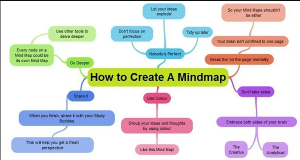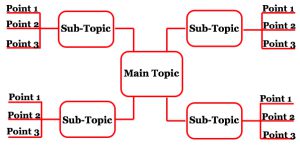Note – Taking
Writing clear, easy to understand notes quickly will help you throughout your program. Discover how to simplify your notes & save yourself time in lectures.
Lots of people spend time writing out full sentences/long phrases in lectures. It can be difficult to keep up with your professors when you do this, and you might miss key information. Meanwhile, some people note down key words and phrases and struggle to understand their notes later.
Writing notes this way is known as note-taking. Note-making on the other hand involves engaging with your subject material. While note-taking involves mimicking the information in front of you, note-making means processing and understanding the content as you write it down. This helps you remember it. Try to think about what you’re writing and summarize or paraphrase the content, or link it to your own ideas or other resources.
Make up your own abbreviations. There are plenty of popular ways to shorten particular common words and phrases but you can use your own abbreviations and symbols too. Write down what each symbol means so you don’t get confused later (see example below).
Three abbreviation techniques:
1. Use the first few letters of the word
Use just enough to remember what the abbreviation stands for. Ensure that there are enough letters to prevent confusion between other words with the same first letters.
imp for ‘important’
info for ‘information’
eval for ‘evaluation’
dev for ‘development’
gov for ‘government’
2. Use initials for phrases
MSVU for ‘Mount Saint Vincent University’
RS for ‘reflective skills’
LG for ‘local government’; FG for ‘federal government’; PG for ‘provincial government’
3. Remove all (or most of) the vowels from the word Use just the key consonants bunched together.
mngmt for ‘management’
mkt for ‘market’ (and mkting for ‘marketing’)
dvpt for ‘development’
Imagine the following lecture:
“The United Kingdom’s population, at around sixty million, is similar to that of Italy, but Italy’s population is now shrinking because its birth rate has fallen below its death rate. The UK’s population is still growing, albeit very slowly – at a rate of 0.09% between 1995 and 2000.”
Your notes could look like:
UK pop c60m ≈ I. BUT I. ↓ due BR < DR – cf. UK ↑ slow ie 0.09% 95 – 2K
This is much quicker to write down than trying to capture the whole sentence, and you haven’t missed any key information. It’s also easy to understand when you know what each symbol means.
Source: University of Portsmouth, UK, https://www.port.ac.uk/
Common note-taking symbols:
& or + and, plus, with
– minus, without
= equals, is the same as, results in
≠ does not equal, is not the same as, does not result in
≈ is approximately equal to, is similar to
< is less than, is smaller than
> is greater than, is larger than
↑ increase, rise, growth
↑↑ rapid increase
↓ decrease, fall, shrinkage
↓↓ rapid decrease
⇒ or ∴ therefore, thus
→ leads on to, produces, causes
x no, not, incorrect
xx definitely not, disproved
? uncertain, possibly, unproven
✓ yes, correct
✓✓ definitely, certain, proven
# number
✳ special, important, notable (when added to a word or phrase)
/ per – for example, $50/day instead of ‘fifty dollars per day’
Common general abbreviations:
c. approximately, roughly, about (abbreviation for the Latin ‘circa’)
e.g. for example
i.e. in other words (usually used when adding more detail or an explanation)
cf. compared to, by comparison with
w/ with
w/o without
v. very
vv. extremely
C century (e.g. C19 for ‘nineteenth century’)
etc. and so on
K or k a thousand (e.g. 500K for ‘five hundred thousand’)
m a million (e.g. $6m for ‘six million dollars’)
vs. against
THE SKETCHNOTE PROCESS
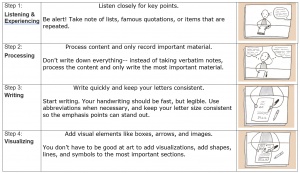
ELEMENTS OF SKETCHNOTING
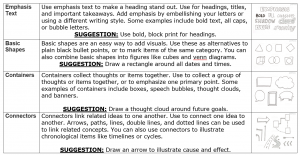
To help organize notes:
Divide the paper into three sections (Example below).
• Draw a dark horizontal line about 5 or 6 lines from the bottom.
• Draw a dark line over the top line of the page.
• Draw a dark vertical line about 2 inches from the left side of the page.
Document
• Write course name, date and topic at the top of each page
Write Notes
• The large box to the right is for writing notes.
• Skip a line between ideas and topics
• Don’t use complete sentences. Use abbreviations, whenever possible. Develop a shorthand of your own, such as using & for the word “and”.
Review and Clarify
• Review the notes as soon as possible after class.
• Pull out main ideas, key points, dates, and people, and write them in the left column.
Summarize
• Write a summary of the main ideas in the bottom section.
Study
• Reread your notes in the right column.
• Spend most of your time studying the ideas in the left column and the summary at the bottom. These are the most important ideas and will probably include most of the information that you will be tested on.
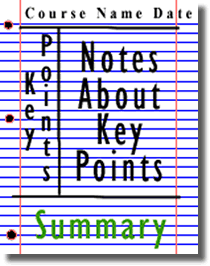
*This strategy is based on a strategy presented in Pauk, W. (1997). How to study in college (6th ed). Boston: Houghton Mifflin. Learning Toolbox. Steppingstone Technology Grant, James Madison University, MSC 1903, Harrisonburg, VA 22807.
Mind Mapping is a powerful note-taking method. Mind Maps not only highlight important facts, but also show the overall structure of a subject and the relative importance of individual parts of it.
They are great when you need to think creatively and can help you to make new connections between ideas. This is useful when you have problems to solve.
To use Mind Maps effectively, it’s best to print your words, to use different colors (to add visual impact), and to incorporate symbols and images to spur creative thinking.
